Weekly Stock Market Technical Analysis Report - 3rd March 2007
Stock-Markets / Forecasts & Technical Analysis Mar 03, 2007 - 01:29 PM GMTBy: Mike_Burk
The good news is: Last Tuesday NASDAQ volume of declining issues (OTC DV) was 24 times the volume of advancing issues (OTC AV). In the past ratios of that magnitude usually occurred near short term lows.
Short Term
Last Tuesday's 24 to 1 ratio of OTC AV / OTC DV ranks 8th highest since 1978, the first year for which I have NASDAQ volume data.
The top 10 are: |
|
Date |
Ratio |
10/19/1987* |
42 |
10/27/1997 |
40 |
10/9/1979* |
38 |
1/28/2004 |
36 |
3/27/1980 |
35 |
10/10/1979* |
31 |
4/14/2000 |
25 |
2/27/2007* |
24 |
3/17/1980 |
22 |
12/8/1980 |
21 |
Four of the 10 occurred during the 3rd year of the Presidential cycle (marked with an asterisk), other than last Tuesday, they all occurred in October. A common characteristic is they occurred near, but not at, short term lows. The charts below show a few of them.
The charts cover 9 months and show the NASDAQ composite (OTC) in red and an indicator showing the percentage of the previous 5 days that the NASDAQ AD line (OTC ADL) was up. The OTC ADL is a running total of NASDAQ advancing issues - declining issues, it is not shown on the charts.
The OTC ADL has had a neutral to negative bias over the years, recently it has been a bit negative. The indicator gives a good overall view of market strength.
The first chart shows the current period.
When the OTC hit its multi year high a little over a week ago the OTC ADL had been up for 7 consecutive days. The OTC ADL has not had 5 consecutive down days since the lows last June.
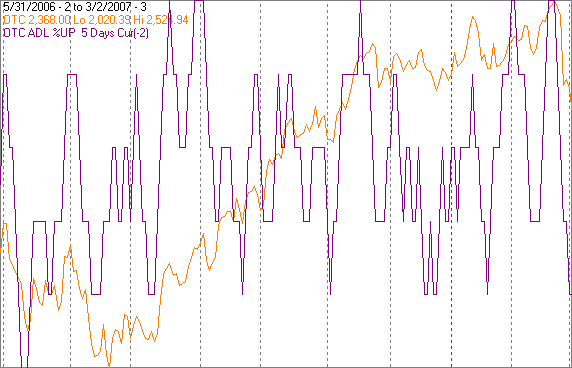
The next chart shows the next most recent time when OTC DV swamped OTC AV. The OTC fell 6.5% than rallied 3% over a week, then fell to its low for the year on May 17, 12.9% off its late January high.
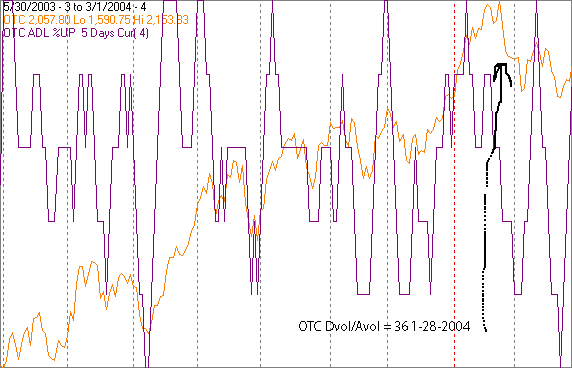
The next most recent occurrence was on April 14, 2000.
After this one the market rallied for a couple weeks to May 1 before falling to a low on May 23. The OTC ADL %UP indicator was much more negative in this chart than in any of the others.
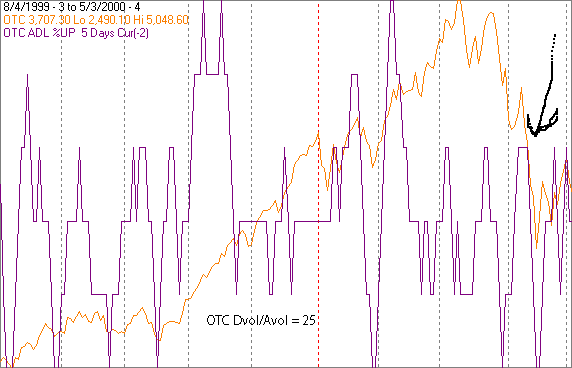
The next most recent occurrence was on October 10, 1997.
After this one the market rallied for a little over a week then retested the old low, rallied for about 3 weeks before falling to a new low in late December.
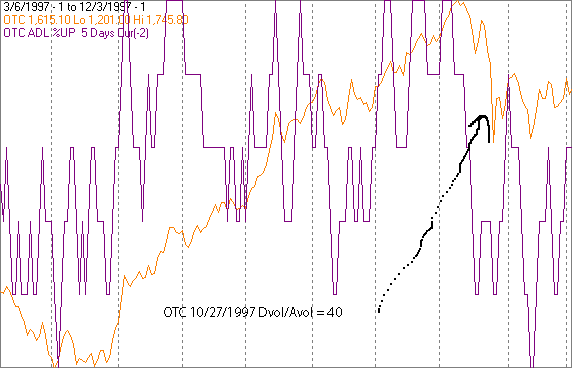
The next most recent was the all time champ 10/19/1987, you probably remember it.
Of the 4 worst declines as measured by OTC AV / OTD DV since the October 1987 crash, the one on 2/27/2007 was the least severe. In every case the occurrence was near a short term low.
Intermediate term
There is usually deterioration in the breadth indicators before a major top and that was not apparent a week ago.
The chart below shows the OTC in red and a 10% trend (19 day EMA) of NASDAQ new highs (OTC NH) in green.
The indicator and index hit new highs simultaneously a little over a week ago.
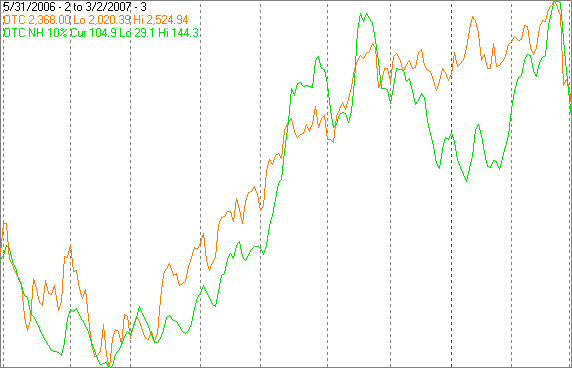
The next chart is similar to the one above except it ends on 5/18/2006.
It shows the April high with OTC NH lower than its high about two and a half months earlier.
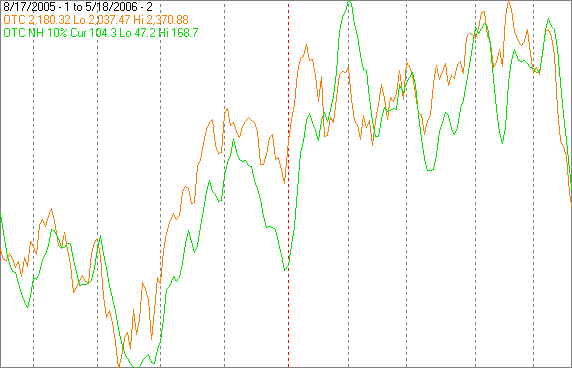
The next chart shows the S&P 500 (SPX) and a new high indicator calculated from NYSE new highs (NY NH) in green).
NY NH hit its high in early December and had progressively lower highs as the SPX hit new highs in February (not unlike the OTC chart of last spring).
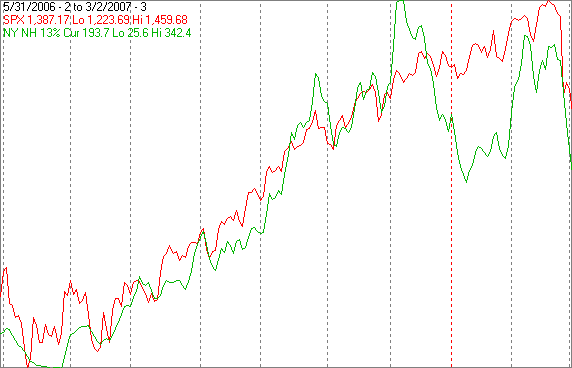
Usually there is deterioration in the small caps ahead of major tops. OTC NH and the Russell 2000 both hit cycle or all time highs less than 2 weeks ago so it is unlikely the severe action of the past week was the beginning of a major decline.
Seasonality
Next week includes the week prior to the 2nd Friday of March during the 3rd year of the Presidential cycle.
The tables below show OTC data from 1963 - 2003 during the 3rd year of the Presidential Cycle and SPX data beginning with 1955.
Data prior to 1953 has been ignored because the market traded 6 days a week.
There are summaries for both the 3rd year of the Presidential Cycle and all years combined.
Next week has had an extremely positive bias. During the 3rd year of the Presidential Cycle the OTC has never been down while the SPX has been up 77% of the time. The averages over all years are not as good as during the 3rd year of the Presidential Cycle, but are still good.
Week prior to the 2nd Friday in March.
The number following the year represents its position in the presidential cycle.
| OTC Presidential Year 3 | ||||||
| Year | Mon | Tue | Wed | Thur | Fri | Totals |
| 1963-3 | -0.23% | 0.33% | 0.07% | 0.29% | 0.52% | 0.98% |
| 1967-3 | 0.44% | 0.00% | 0.49% | 0.33% | 1.16% | 2.42% |
| 1971-3 | 1.15% | 0.17% | -0.26% | 0.12% | 0.23% | 1.41% |
| 1975-3 | 0.65% | 0.21% | -1.21% | 0.74% | 1.86% | 2.25% |
| 1979-3 | 0.85% | -0.23% | 0.95% | 1.15% | 0.16% | 2.87% |
| 1983-3 | -0.21% | -0.84% | 0.72% | 0.38% | 0.04% | 0.10% |
| Avg | 0.58% | -0.17% | 0.14% | 0.54% | 0.69% | 1.81% |
| 1987-3 | -0.62% | 0.61% | 0.48% | 0.24% | -0.12% | 0.59% |
| 1991-3 | 0.96% | 2.58% | 0.16% | 0.41% | -0.13% | 3.98% |
| 1995-3 | -0.13% | -0.81% | 0.57% | 0.05% | 0.75% | 0.44% |
| 1999-3 | 2.59% | -0.20% | 0.55% | 0.26% | -1.28% | 1.93% |
| 2003-3 | -2.06% | -0.54% | 0.61% | 4.81% | -0.03% | 2.79% |
| Avg | 0.15% | 0.33% | 0.47% | 1.16% | -0.16% | 1.94% |
| OTC summary for Presidential Year 3 1963 - 2003 | ||||||
| Avg | 0.31% | 0.13% | 0.28% | 0.80% | 0.29% | 1.80% |
| Win% | 55% | 50% | 82% | 100% | 64% | 100% |
| OTC summary for all years 1963 - 2006 | ||||||
| Avg | 0.09% | 0.15% | 0.00% | 0.27% | -0.07% | 0.43% |
| Win% | 50% | 56% | 64% | 64% | 52% | 68% |
| SPX Presidential Year 3 | ||||||
| Year | Mon | Tue | Wed | Thur | Fri | Totals |
| 1955-3 | -0.64% | -1.88% | -0.98% | 0.64% | -1.73% | -4.59% |
| 1959-3 | -0.11% | 0.28% | 0.07% | 0.44% | 0.12% | 0.82% |
| 1963-3 | 0.97% | 0.03% | 0.17% | 0.63% | 0.11% | 1.91% |
| 1967-3 | -0.22% | 0.07% | 0.12% | 0.29% | 0.41% | 0.68% |
| 1971-3 | 0.42% | 0.08% | -0.16% | 0.09% | 0.18% | 0.62% |
| 1975-3 | 0.77% | -0.69% | -0.91% | 0.18% | 1.22% | 0.56% |
| 1979-3 | 1.12% | -0.19% | 0.58% | 1.16% | -0.04% | 2.63% |
| 1983-3 | 0.00% | -1.57% | 1.06% | -0.70% | -0.37% | -1.57% |
| Avg | 0.53% | -0.46% | 0.14% | 0.20% | 0.28% | 0.58% |
| 1987-3 | -0.81% | 0.89% | -0.19% | 0.31% | -0.46% | -0.26% |
| 1991-3 | -0.31% | 2.00% | -0.15% | -0.07% | -0.26% | 1.22% |
| 1995-3 | 0.04% | -0.72% | 0.21% | 0.00% | 1.33% | 0.86% |
| 1999-3 | 0.56% | -0.23% | 0.55% | 0.85% | -0.24% | 1.49% |
| 2003-3 | -2.58% | -0.84% | 0.43% | 3.45% | 0.16% | 0.62% |
| Avg | -0.62% | 0.22% | 0.17% | 0.91% | 0.11% | 0.79% |
| SPX summary for Presidential Year 3 1955 - 2003 | ||||||
| Avg | -0.06% | -0.21% | 0.06% | 0.56% | 0.03% | 0.38% |
| Win% | 50% | 46% | 62% | 85% | 54% | 77% |
| SPX summary for all years 1953 - 2006 | ||||||
| Avg | 0.01% | 0.08% | 0.06% | 0.11% | -0.06% | 0.21% |
| Win% | 56% | 54% | 56% | 58% | 43% | 59% |
March
The OTC has been up 58% of the time in March with an average return of 0.1%. However, during the 3rd year of the Presidential Cycle the OTC has never been down and averaged a 3.9% return.
The charts below are calculated by assuming a month of 21 trading days.
The average daily return is calculated for the first 11 trading days and the last 10. The solid vertical line is drawn at the dividing point.
The chart below shows the OTC average over all years since 1963 in orange and the average during the 3rd year of the Presidential Cycle in blue.
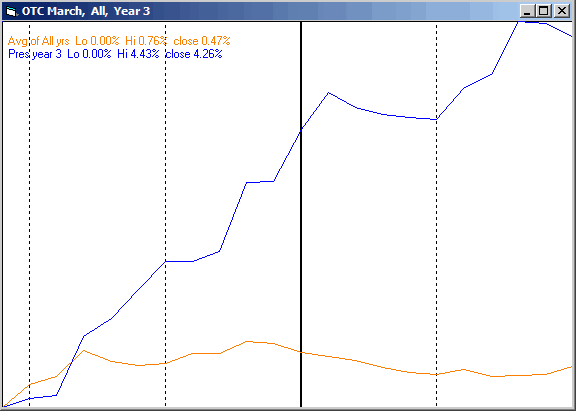
My SPX data goes back to 1928 and during that time the SPX has been up 59% of the time in March with an average gain of 0.1%. The results for the 3rd year of the Presidential Cycle have been slightly better with the index up 60% of the time and the average gain 0.4%. However, between 1931 and 1959 the SPX was only up once (1943) in March during the 3rd year of the Presidential Cycle. Beginning with 1963 it, like the OTC, has never been down.
The chart below is like the one above except the data is for the SPX from 1928. Unfortunately I do not have the capability of charting the data beginning with 1963 which would produce a very different, and more positive, chart.
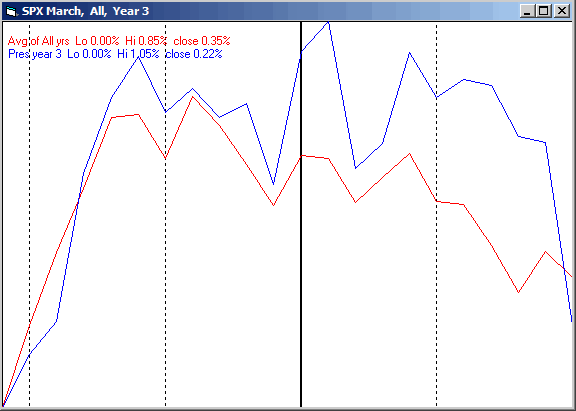
The Alpha Fund (APHAX)
The Alpha Fund, which I manage, opened last October.
Last week YTD
APHAX -0.5% +2.0%
For information about the fund go to: http://www.thealphafunds.com/index.htm .
Conclusion
The market is oversold and seasonally next week is positive.
I expect the major indices to be higher on Friday March 9 than they were on Friday March 2.
By Mike Burke
Mike Burk is an employee and principle of Alpha Investment Management (Alpha) a registered investment advisor. Charts and figures presented herein are believed to be reliable but we cannot attest to their accuracy. The views expressed are provided for information purposes only and should not be construed in any way as investment advice. Furthermore, the opinions expressed may change without notice. To subscribe to this report : http://alphaim.net/signup.html
© 2005-2022 http://www.MarketOracle.co.uk - The Market Oracle is a FREE Daily Financial Markets Analysis & Forecasting online publication.



